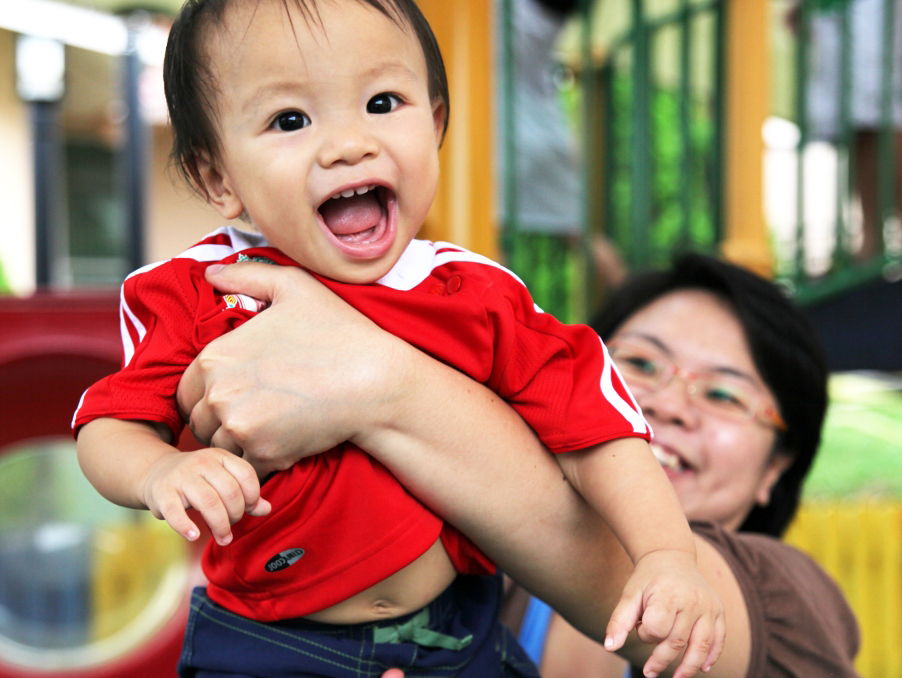Tooth decay among young kids: 10 tips to keep cavities at bay
Sign up now: Get ST's newsletters delivered to your inbox

A one-year-old boy showing his teeth.
PHOTO: NATIONAL DENTAL CENTRE
Timothy Goh
Follow topic:
SINGAPORE - Have a young child who complains of toothaches? Your toddler is not alone - at least 50 per cent of pre-schoolers in Singapore have tooth decay, according to paediatric dentist Badrun Nafis from Thomson Paediatric Centre (Katong). In addition, 38.4 per cent of Singapore's pre-schoolers suffer from severe early childhood decay.
If left untreated, decaying milk-teeth can affect the development of children's permanent teeth. Here are 10 tips on how to keep your child's smile healthy and decay-free.
1. Beware the bottle
Avoid putting your child to bed with a bottle containing formula milk or any other sweetened fluids. As saliva flow tends to be reduced during sleep, the liquid from the bottle will pool around the teeth and stay there for a long time, which increases the risk of decay.
During the daytime, do not use a bottle of milk or juice as a pacifier or let your child walk around with a bottle in his mouth.
2. Less sweet treats
The bacteria in one's mouth interacts with sugar from food and drinks to produce acids, which dissolve and damage the teeth. Saliva helps to reduce the harmful effects of this acid.
As such, limit your child's sweet snacks and drinks to the main meal times, as this is when saliva flow is greatest.
Additionally, since most children have a sweet tooth, parents should encourage them to consume less food and drinks containing added sugar.
3. Formula milk may cause tooth decay
Formula milk tends to have a higher sugar content than breast milk and fresh milk, and is more likely to cause cavities. The regular intake of formula milk may result in tooth decay.
4. Care, don't share
Avoid sharing utensils with your young child, or "cleaning" a pacifier by putting it into your mouth. This is because your mouth may contain cavity-causing bacteria, which can pass from the saliva in your mouth to your child's mouth.
5. Begin brushing early
Begin brushing your child's teeth twice a day with a wet toothbrush as soon as the first tooth erupts.
You should begin to teach your child how to brush his teeth with toothpaste once he is old enough to spit. This generally begins at around age two or three.
6. Let your child take over, but not too soon
Continue to brush your child's teeth for him until he has the dexterity to do so himself. This will generally occur at around age seven, or when your child is able to tie his own shoelaces.
Even after your child begins brushing his own teeth, you should continue to supervise him and check areas such as the back and inner surfaces of the teeth to make sure those areas are properly brushed.
7. Brush up on good brushing habits
Teeth should be brushed at least twice a day - once in the morning and once at night. Children should spend at least three minutes brushing.
When brushing teeth, the toothbrush bristles should be placed at the junction between the gums and teeth. All three surfaces of the teeth - the outer, inner and chewing surfaces of upper and lower teeth - should be brushed thoroughly.
8. Choose the right toothbrush
Toothbrushes for children should have small heads and soft bristles. The toothbrush should be changed when the bristles are worn out, as such toothbrushes may injure the gums and will be less effective in removing plaque.
9. Teach your child to eat right
Strong sources of calcium such as low-fat milks, cheese, yogurt, and broccoli are crucial in building strong teeth. Lean meats, nuts, and proteins also help to strengthen tooth enamel.
Finally, crunchy fruits and vegetables with high water content such as celery, pears, and cucumbers, help to clean the teeth by removing some substances that adhere to the teeth when eating.
10. Visit the dentist
Start taking your child to the dentist when he turns one, or when he gets his first tooth. This will allow dental problems to be managed early, and will make subsequent dental visits less traumatic for your child.
Parents who wish to access basic dental treatment for their pre-schooling children may bring them to polyclinics, or to the School Dental Centre located at the Health Promotion Board (HPB).
Sources: American Dental Association, Health Promotion Board, KidsDental, Ministry of Health, Q&M Kids, Thomson Paediatric Centre (Katong)

